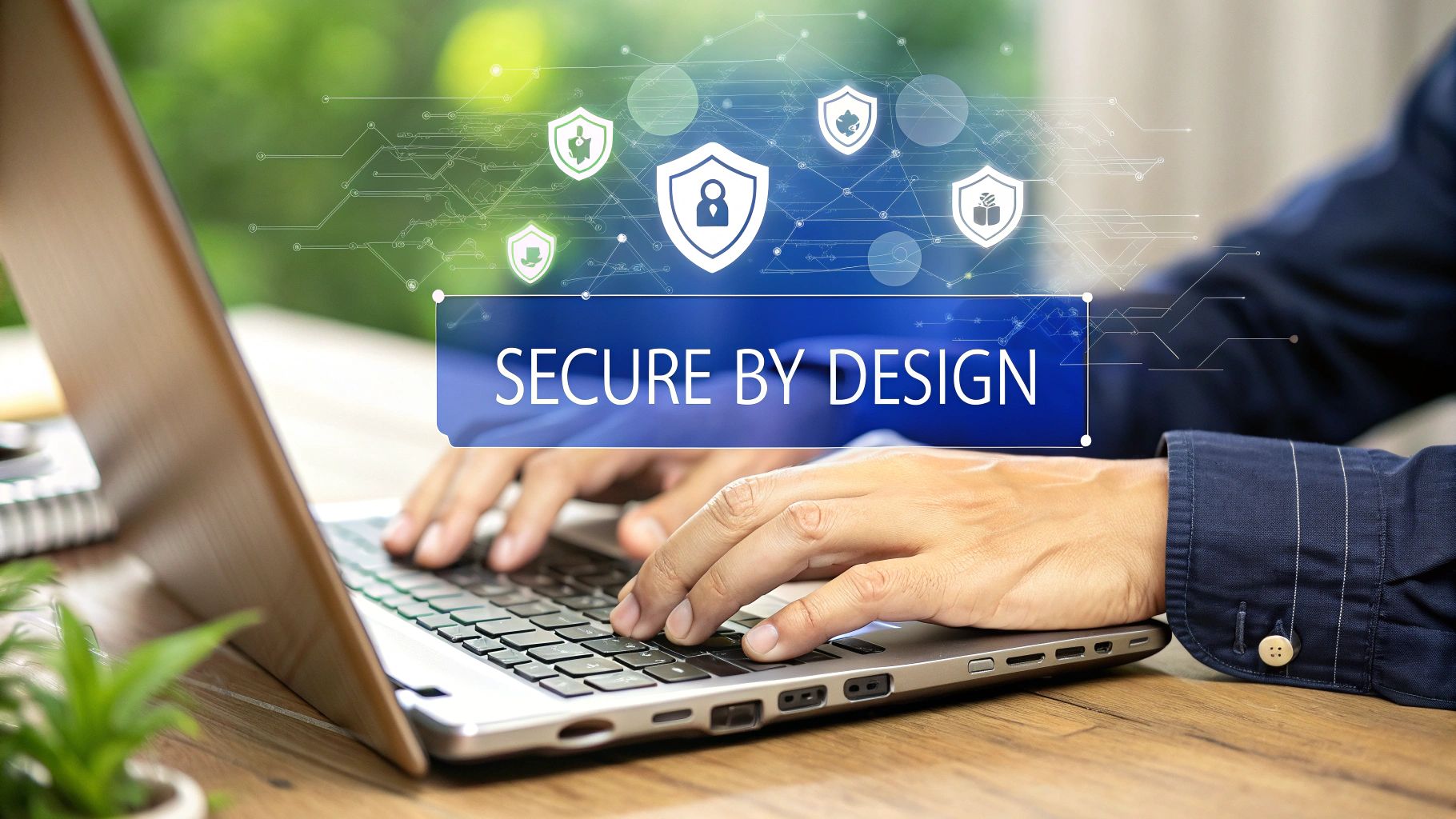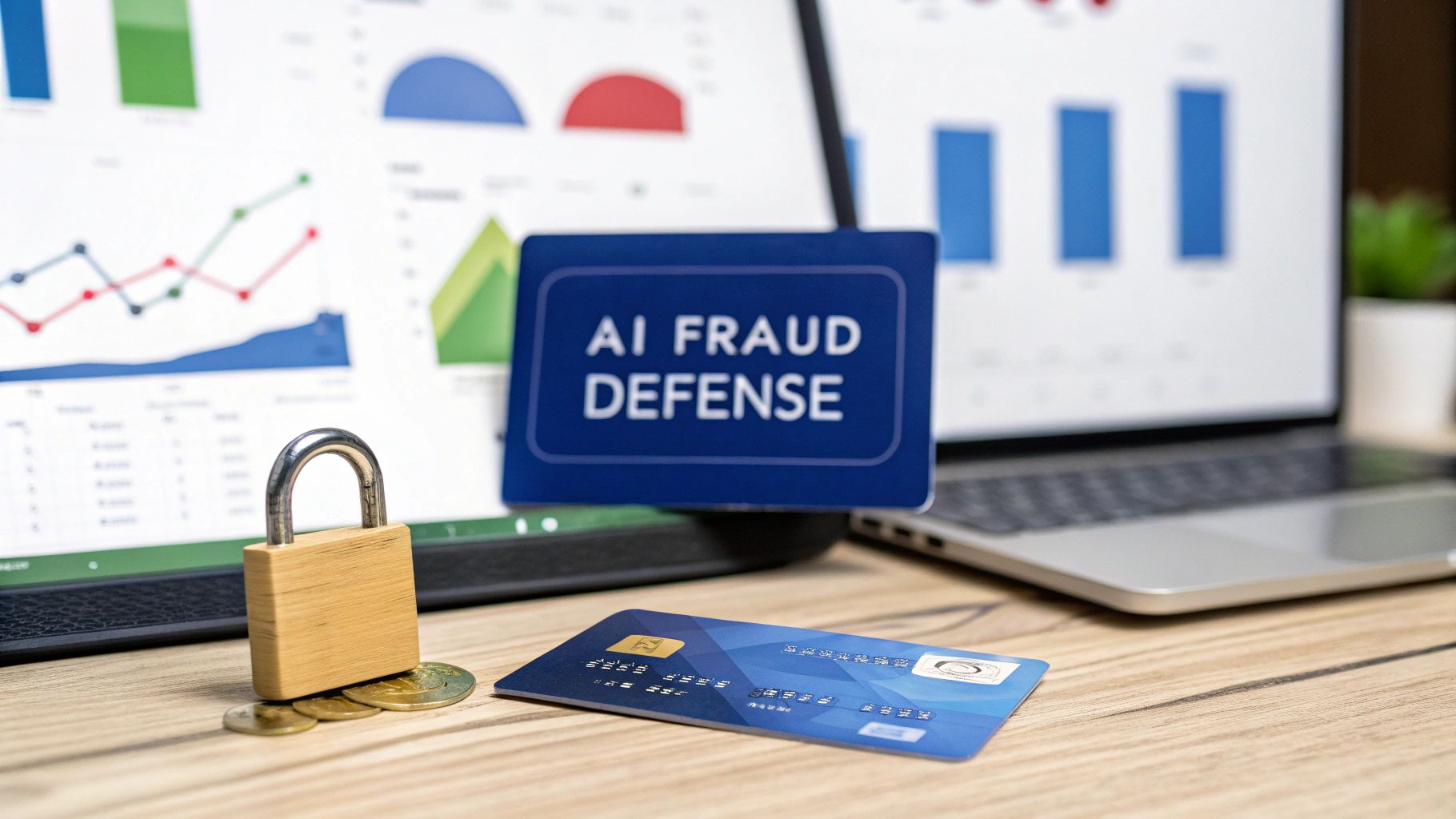In a hyper-connected economy, the integrity of your software is not merely a technical detail; it is the bedrock of customer trust, operational stability, and long-term business resilience. As cyber threats grow in sophistication and frequency, the old paradigm of bolting on security measures after development is no longer viable. Reactive defences like firewalls and antivirus software, while necessary, are insufficient on their own. The most effective security posture is proactive, with robust defences meticulously woven into the fabric of your application from its very inception.
This guide moves beyond theoretical concepts to provide a clear, actionable roadmap. We will delve into nine mission-critical software security best practices that form the foundation of a modern, resilient development process. From implementing secure coding standards and the principle of least privilege to mastering data encryption and vulnerability assessments, each practice is a vital layer in a comprehensive defence strategy.
By adopting these principles, your organisation can transition from a reactive, crisis-management approach to a proactive, security-first culture. You will learn how to build applications that are secure by design, significantly reducing the risk of costly breaches, protecting sensitive data, and safeguarding your company’s reputation. This listicle is designed for startups, small businesses, and large enterprises alike, offering the practical insights needed to transform security from a late-stage hurdle into a core competitive advantage. Let's explore the essential strategies that will fortify your software from the inside out.
1. Secure Coding Standards and Code Reviews
One of the most foundational software security best practices involves establishing and enforcing secure coding standards throughout the development lifecycle. This proactive approach focuses on writing code that is inherently resilient to common vulnerabilities, such as SQL injection, cross-site scripting (XSS), and buffer overflows. By integrating security principles directly into the coding process, organisations can significantly reduce their attack surface before the software is even deployed.
This practice is not just about writing code; it's about creating a security-first culture. It combines formal guidelines, automated analysis, and human oversight. Developers follow a defined set of rules, often based on industry-recognised standards from organisations like the Open Web Application Security Project (OWASP). This is complemented by rigorous code reviews, where peers and security experts scrutinise code for potential flaws, logic errors, and deviations from established standards.

Why It's a Core Practice
Adopting secure coding standards is essential because it shifts security "left," integrating it into the earliest stages of development. This is far more cost-effective than discovering and remediating vulnerabilities in production software. Tech giants like Microsoft, with its Security Development Lifecycle (SDL), and Google have championed this approach, proving its effectiveness in reducing security incidents at scale. For small businesses and startups, this preventative measure is crucial for building customer trust and avoiding the catastrophic costs associated with a data breach.
Actionable Implementation Tips
To effectively implement secure coding standards and code reviews, consider the following strategies:
-
Integrate Static Analysis (SAST) Tools: Automate the detection of vulnerabilities by embedding tools like Veracode or Checkmarx directly into your Continuous Integration/Continuous Deployment (CI/CD) pipeline. This provides immediate feedback to developers.
-
Develop Security-Focused Checklists: Create and maintain a detailed checklist for peer code reviews. This list should cover common vulnerabilities specific to your technology stack, such as input validation, error handling, and authentication logic.
-
Provide Ongoing Training: Regularly train your development team on secure coding principles and emerging threats. This ensures they understand the "why" behind the standards, not just the "what."
-
Utilise IDE Plugins: Encourage the use of real-time security plugins within Integrated Development Environments (IDEs). These tools can flag potential issues as developers write code, preventing vulnerabilities from ever being committed.
2. Multi-Factor Authentication (MFA) Implementation
Another crucial pillar among software security best practices is the robust implementation of Multi-Factor Authentication (MFA). This security control moves beyond traditional password-only access by requiring users to provide two or more verification factors to gain access to a resource. MFA significantly strengthens authentication security by combining something you know (like a password or PIN), something you have (like a mobile device or hardware token), and something you are (like a fingerprint or facial scan), making it exponentially more difficult for unauthorised users to compromise an account.

This practice is about building layered defences at the most common point of entry: the login screen. By demanding additional proof of identity, MFA effectively neutralises the risks associated with compromised credentials, which are a leading cause of data breaches. It transforms a single point of failure (a stolen password) into a multi-layered barrier that requires physical access to a device or a user's unique biometric data to overcome, a foundational concept for any modern cybersecurity for business strategy.
Why it's a Core Practice
Implementing MFA is essential because compromised credentials are the primary attack vector in the vast majority of security incidents. Even the strongest password can be phished, leaked, or brute-forced. Tech leaders like Google and Microsoft have made MFA mandatory for their employees and heavily promote it for users, drastically reducing account takeover incidents. For small and medium-sized businesses, enforcing MFA across critical applications (email, VPN, cloud services) is one of the most cost-effective measures to prevent a devastating breach and protect sensitive company and customer data.
Actionable Implementation Tips
To successfully deploy Multi-Factor Authentication in your organisation, consider these strategies:
-
Implement Risk-Based Authentication: Configure your system to require MFA only in higher-risk scenarios, such as when a user logs in from an unrecognised device or a new geographical location. This balances strong security with user convenience.
-
Provide Multiple MFA Options: Offer a choice of authentication methods, including authenticator apps (like Google Authenticator), push notifications, hardware tokens (like YubiKey), and biometrics. This accommodates diverse user needs and preferences.
-
Prioritise Push Notifications Over SMS: Where possible, favour app-based push notifications for MFA. SMS messages are more susceptible to SIM-swapping attacks and are generally considered a less secure verification channel.
-
Establish Clear Backup and Recovery Procedures: Ensure users have a secure and straightforward process for recovering their accounts if they lose their primary MFA device. This prevents lockouts while maintaining security integrity.
3. Regular Security Updates and Patch Management
A critical pillar of any robust security strategy is the systematic application of security updates and patches. This foundational software security best practice involves continuously identifying, testing, and deploying updates for all software components, including operating systems, third-party libraries, and application dependencies. The goal is to close security gaps discovered by vendors or the security community before malicious actors can exploit them.
This process extends beyond simply clicking "update." It requires a comprehensive patch management program that maintains a complete inventory of all software assets and establishes clear procedures for timely deployment. By treating patching as a non-negotiable, routine operation, organisations can significantly reduce their vulnerability to known threats and maintain the integrity of their software ecosystem.

Why it's a Core Practice
Unpatched vulnerabilities are one of the most common entry points for attackers. The infamous 2017 Equifax breach, which exposed the sensitive data of nearly 150 million people, was caused by the failure to patch a known vulnerability in the Apache Struts framework. This highlights how a single missed patch can have catastrophic consequences. Organisations like Microsoft, with its long-standing "Patch Tuesday," and Red Hat have institutionalised regular update cycles, demonstrating that proactive patch management is essential for defending against an ever-evolving threat landscape.
Actionable Implementation Tips
To effectively implement a regular update and patch management program, consider the following strategies:
-
Maintain a Comprehensive Asset Inventory: You cannot protect what you do not know you have. Use automated tools to discover and maintain a real-time inventory of all software, libraries, and operating systems in your environment.
-
Implement Automated Patch Scanning: Utilise tools like Qualys VMDR or AWS Systems Manager Patch Manager to automatically scan for missing patches and generate reports. This helps prioritise patching efforts based on vulnerability severity.
-
Establish Clear Service Level Agreements (SLAs): Define and enforce strict timelines for applying patches. For example, critical vulnerabilities might require patching within 48 hours, while less severe ones could be addressed within 30 days.
-
Monitor Vendor Security Advisories: Actively track security bulletins and Common Vulnerabilities and Exposures (CVE) databases from your software vendors. This ensures you are immediately aware of newly discovered vulnerabilities and available fixes.
-
Use a Staged Deployment Approach: Test patches in a non-production environment (development or testing) before rolling them out to production. This minimises the risk of updates causing unintended operational disruptions.
4. Principle of Least Privilege Access Control
A cornerstone of any robust security model, the Principle of Least Privilege (PoLP) dictates that a user, program, or system should have only the bare minimum permissions necessary to perform its legitimate functions. This fundamental concept in software security best practices acts as a powerful containment strategy. By severely restricting access rights, it minimises the potential damage from accidental misuse, compromised accounts, or malicious insider activity, effectively shrinking the blast radius of a security incident.
This principle is not about denying access but about precision and necessity. It shifts the default security posture from permissive to restrictive, where access is an explicit exception rather than an implicit rule. Instead of granting broad administrative rights, developers and IT teams meticulously define roles and permissions that align precisely with required tasks. This granular control is crucial for protecting sensitive data and critical system functions from unauthorised exposure or modification.

Why it's a Core Practice
Implementing the Principle of Least Privilege is essential because it directly mitigates a wide array of threats. A compromised low-privilege account is an inconvenience; a compromised administrator account is a catastrophe. This model is foundational to modern security frameworks like Zero Trust, which assumes no user or device is inherently trustworthy. Major cloud providers like AWS and Google Cloud have built their Identity and Access Management (IAM) services around this very principle, enabling organisations of all sizes to build secure, scalable infrastructures. For businesses in regulated industries like healthcare and finance, enforcing PoLP is often a core compliance requirement.
Actionable Implementation Tips
To effectively implement the Principle of Least Privilege in your organisation, consider the following strategies:
-
Start with a "Deny-All" Policy: Establish a baseline where no permissions are granted by default. Explicitly add only the specific permissions required for a user or service to function, ensuring no unnecessary access is granted.
-
Use Service Accounts with Minimal Scope: When applications need to interact with other systems or APIs, create dedicated service accounts with tightly scoped, single-purpose permissions rather than using highly privileged user accounts.
-
Implement Automated Access Reviews: Deploy tools to regularly review and certify user access rights. This process helps identify and remove excessive or obsolete permissions that accumulate over time, a phenomenon known as "privilege creep."
-
Monitor for Privilege Escalation: Actively monitor for and alert on any attempts by users or applications to gain higher-level permissions than they have been assigned. This is often a key indicator of a security breach in progress.
5. Data Encryption (at Rest and in Transit)
A critical component of any robust security strategy is the cryptographic protection of sensitive data. This is one of the most vital software security best practices because it ensures information remains confidential and integral, whether it is being stored on a server (at rest) or transmitted across a network (in transit). By converting readable data into an unreadable format using strong algorithms, encryption acts as the last line of defence against unauthorised access, even if other security measures fail.
This practice involves a two-pronged approach. Data in transit is secured using protocols like Transport Layer Security (TLS) to protect information as it moves between a client and a server. Data at rest is protected by encrypting files, databases, or entire storage volumes, safeguarding information stored on hard drives, in the cloud, or on backup media. Effective implementation requires not just strong ciphers but also stringent key management processes.
Why it's a Core Practice
Encrypting data is non-negotiable for protecting privacy, maintaining regulatory compliance (like with GDPR and PIPEDA), and building customer trust. A data breach involving unencrypted information can be catastrophic, leading to severe financial penalties and reputational damage. The widespread adoption of TLS, championed by organisations like Let's Encrypt, has made securing web traffic the standard. Similarly, cloud providers like AWS offer robust server-side encryption for services like S3, while platforms like WhatsApp popularised end-to-end encryption, proving its feasibility at a massive scale. For any business, from a small e-commerce site to a healthcare provider, encryption is essential for safeguarding its most valuable asset: its data.
Actionable Implementation Tips
To effectively implement data encryption across your software and infrastructure, consider these strategies:
-
Enforce TLS for All Communications: Mandate the use of TLS 1.2 or higher for all data in transit. Utilise services like Let's Encrypt to automate certificate management and ensure universal encryption.
-
Implement a Strict Key Management Policy: Use a dedicated key management system (KMS) or a Hardware Security Module (HSM) for high-value keys. Never store encryption keys alongside the encrypted data they protect.
-
Choose Industry-Standard Algorithms: Rely on well-vetted, strong encryption algorithms such as AES-256 for symmetric encryption and RSA-2048 (or higher) for asymmetric encryption. Avoid proprietary or outdated ciphers.
-
Automate Key Rotation: Establish and automate policies for regularly rotating encryption keys. This minimises the potential damage if a key is ever compromised.
6. Security Testing and Vulnerability Assessments
While secure coding standards build security into the software from the ground up, continuous testing ensures that those defences hold strong. This software security best practice involves a systematic process of identifying, quantifying, and prioritising vulnerabilities in an application. It is a proactive approach designed to uncover security weaknesses before malicious actors can exploit them, covering everything from penetration testing to automated vulnerability scanning.
This practice is about actively trying to break the software in a controlled, ethical manner. It combines automated tools that scan for known vulnerabilities with manual, human-led efforts that probe for complex logic flaws and undiscovered weaknesses. By simulating real-world attacks, organisations can validate their security controls and understand their risk posture, a process popularised by frameworks like the OWASP Testing Guide and NIST SP 800-115.
Why it's a Core Practice
Security testing is essential because no software is perfect, and new threats emerge daily. It provides a critical feedback loop, revealing blind spots that developers and architects may have missed. Tech leaders like Netflix integrate continuous security testing directly into their production environments, while Google's Vulnerability Reward Program incentivises ethical hackers to find bugs. For small and medium-sized businesses, regular testing is a crucial mechanism for maintaining compliance and protecting sensitive customer data from evolving threats.
Actionable Implementation Tips
To effectively implement security testing and vulnerability assessments, consider the following strategies:
-
Integrate Security Testing into CI/CD: Automate Dynamic Application Security Testing (DAST) and API security testing tools like OWASP ZAP within your pipeline. This ensures that every new build is automatically scanned for common vulnerabilities. Learn more about API security testing.
-
Combine Automated and Manual Testing: Use automated scanners for broad coverage to find low-hanging fruit, and supplement this with manual penetration testing to uncover complex business logic flaws and nuanced vulnerabilities that tools often miss.
-
Establish a Vulnerability Management Program: A crucial component of security testing is the regular execution of a vulnerability assessment. Create a formal process for tracking, triaging, and remediating identified flaws based on their severity and potential impact on the business.
-
Test Authenticated and Unauthenticated Scenarios: Ensure your testing covers all user roles and access levels. An unauthenticated attacker has a different perspective than a malicious insider, and it is vital to test for vulnerabilities from both viewpoints.
7. Input Validation and Sanitization
A critical pillar among software security best practices is the rigorous implementation of input validation and sanitization. This practice involves treating all data from external sources, especially user input, as untrusted. It establishes a defensive gateway that meticulously checks every piece of incoming data to ensure it conforms to expected types, formats, lengths, and ranges before it is processed or stored. This prevents malicious payloads from executing and corrupting your system.
This approach is twofold. Validation confirms that the data is what it claims to be, for example, a phone number field contains only numbers and appropriate symbols. Sanitization then neutralises or removes potentially dangerous characters or scripts from the input, rendering them harmless. Together, they form a primary defence against a wide range of common injection attacks, including SQL injection, Cross-Site Scripting (XSS), and command injection, which exploit an application's trust in user-supplied data.
Why it's a Core Practice
Input validation is fundamental because it directly thwarts attackers' attempts to manipulate your application's logic. Failing to validate input is like leaving your front door unlocked; it provides a direct path for exploits. Industry leaders like the OWASP Foundation and Microsoft's Security Development Lifecycle place enormous emphasis on this practice. For any business, particularly small businesses and those in regulated sectors like healthcare, robust input validation is non-negotiable for protecting sensitive data, maintaining application integrity, and building a foundation of trust with users.
Actionable Implementation Tips
To effectively implement input validation and sanitization, apply the following strategies:
-
Always Validate on the Server-Side: Never trust client-side validation alone, as it can be easily bypassed. Use server-side checks as the ultimate authority on data integrity. For deeper insights, you can explore web application security best practices on cleffex.com.
-
Use Whitelist Validation: Instead of trying to block a list of known "bad" inputs (blacklisting), define and allow only a set of known "good" inputs (whitelisting). This is a far more secure and manageable approach.
-
Implement Context-Specific Output Encoding: When displaying user-provided data, encode it appropriately for the context in which it will be rendered (e.g., HTML, JavaScript, URL). Libraries like OWASP's Java Encoder are designed for this purpose.
-
Utilise Parameterized Queries: For all database interactions, use parameterized statements or prepared statements. This ensures that user input is treated as data, not as executable code, effectively preventing SQL injection attacks.
8. Secure Software Development Lifecycle (SSDLC)
A Secure Software Development Lifecycle (SSDLC) is a holistic framework that integrates security activities into every stage of software creation. This is one of the most critical software security best practices because it formalises the idea of building security in from the very beginning, rather than treating it as an isolated step or an afterthought. An SSDLC ensures that from initial requirements gathering to deployment and ongoing maintenance, security is a shared responsibility and a core consideration.
This approach transforms security from a final-stage gatekeeper into a continuous process. By embedding security tasks like threat modelling, static analysis, and penetration testing directly into the development workflow, organisations can systematically identify and mitigate risks early. Methodologies like Microsoft's Security Development Lifecycle (SDL) and frameworks like OWASP SAMM provide structured roadmaps for implementing this practice, making it adaptable for teams of any size.
Why it's a Core Practice
Adopting an SSDLC is fundamental because it provides a structured, repeatable, and measurable process for producing secure software. It addresses vulnerabilities at their source, which is significantly more efficient and less expensive than patching them in a live environment. This proactive stance is essential for meeting regulatory compliance, protecting brand reputation, and building customer trust. Companies like Cisco and Adobe have demonstrated that a formal SSDLC not only reduces security incidents but also fosters a more robust and resilient engineering culture.
Actionable Implementation Tips
To effectively implement a Secure Software Development Lifecycle, consider the following strategies:
-
Start with Threat Modelling: During the design and requirements phase, conduct threat modelling sessions. This helps your team anticipate potential threats and design countermeasures before a single line of code is written.
-
Integrate Security Gates: Establish clear security checkpoints or "gates" at each milestone of your development process. For example, code cannot move to the testing phase until it passes an automated static analysis scan with no critical vulnerabilities.
-
Provide Role-Specific Training: Offer security training tailored to different roles. Developers need secure coding training, while QA engineers should learn security testing techniques, and project managers must understand security-related risks and timelines.
-
Establish Security Champions: Identify and empower security-minded individuals within development teams to act as "security champions." These champions serve as the go-to security resource for their team, helping to bridge the gap between development and security.
9. Security Logging and Monitoring
A crucial aspect of any robust security posture is the ability to see what is happening within your systems. This is where software security best practices like comprehensive security logging and real-time monitoring become indispensable. This practice involves systematically recording security-relevant events, such as user logins, access control changes, and system errors, and then continuously analysing this data to detect and respond to potential threats.
The goal is to create a detailed audit trail that provides visibility into system activities. This information is then fed into monitoring systems, which use it to identify anomalies, suspicious patterns, and active security incidents. By centralising and correlating logs from various sources, organisations can move from a reactive to a proactive defence, identifying breaches as they happen rather than weeks or months later.
Why it's a Core Practice
Effective logging and monitoring are non-negotiable because you cannot protect against threats you cannot see. Without this visibility, a security breach could go undetected indefinitely, allowing attackers to exfiltrate data, cause damage, and establish a persistent presence. This practice is the foundation of incident response and forensic analysis. Industry-leading Security Information and Event Management (SIEM) solutions like Splunk and Microsoft Sentinel are used by major enterprises to aggregate and analyse petabytes of log data, enabling them to detect sophisticated attacks. For small and medium-sized businesses, open-source solutions like the ELK Stack (Elasticsearch, Logstash, Kibana) offer powerful capabilities to achieve the same level of oversight, ensuring compliance and rapid threat detection.
Actionable Implementation Tips
To build an effective security logging and monitoring program, consider these strategies:
-
Log Critical Security Events: Ensure you are logging all authentication attempts (both successful and failed), changes to privileges, and high-value transactions. This data is vital for tracing unauthorised activity.
-
Implement Centralised Log Management: Use a centralised system to collect, store, and analyse logs from all applications, servers, and network devices. This provides a unified view and simplifies correlation.
-
Use Structured Logging Formats: Adopt structured formats like JSON. This makes logs machine-readable, allowing for easier parsing, searching, and analysis by automated monitoring tools.
-
Set Up Automated Alerting: Configure your monitoring system to generate real-time alerts for critical security events, such as multiple failed login attempts from a single IP address or unauthorised access to sensitive files.
-
Protect Log Integrity: Implement measures to prevent log tampering, such as write-once storage and digital signatures. Regularly back up logs to a secure, offsite location to ensure they are available for forensic investigation.
9 Key Software Security Practices Comparison
|
Security Practice |
Implementation Complexity |
Resource Requirements |
Expected Outcomes |
Ideal Use Cases |
Key Advantages |
|---|---|---|---|---|---|
|
Secure Coding Standards and Code Reviews |
Moderate to High (training, process) |
Skilled developers, static analysis tools |
Early vulnerability detection, improved code quality |
The software development phase requires secure coding |
Early flaw detection, security awareness, and reducing security debt |
|
Multi-Factor Authentication (MFA) Implementation |
Moderate (integration with IdPs, tokens) |
Infrastructure for MFA, support teams |
Stronger authentication, reduced account compromise |
User authentication for sensitive systems |
Significant risk reduction, regulatory compliance |
|
Regular Security Updates and Patch Management |
Moderate to High (coordination, testing) |
Patch management tools, testing environments |
Reduced attack surface, closed vulnerabilities |
Operating systems, software maintenance |
Closes known vulnerabilities, ensures compliance, and reduces exploits |
|
Principle of Least Privilege Access Control |
High (policy design, implementation) |
Access control systems, audit tools |
Minimized access risks, improved compliance |
Identity and access management |
Limits the damage scope, making regulatory compliance and auditing easier |
|
Data Encryption (At Rest and In Transit) |
High (encryption tech, key management) |
Cryptographic tools, HSMs, and expert knowledge |
Data protection against breaches, regulatory compliance |
Protecting sensitive data stored or transmitted |
Data confidentiality, breach defense, and secure cloud use |
|
Security Testing and Vulnerability Assessments |
Moderate to High (tools + expertise) |
Skilled testers, automated tools |
Identification of security weaknesses before attacks |
Continuous security validation across SDLC |
Detects vulnerabilities early, validates controls, prioritizes fixes |
|
Input Validation and Sanitization |
Low to Moderate (coding best practices) |
Developer time, validation libraries |
Prevents injection attacks, improves data quality |
Web/application input handling |
Prevents injection attacks, ensures data integrity |
|
Secure Software Development Lifecycle (SSDLC) |
High (organization-wide process change) |
Training, secure tools, process integration |
Reduced vulnerabilities, secure by design |
Organizations aiming for holistic software security |
Integrates security throughout SDLC, cost-effective fixes |
|
Security Logging and Monitoring |
Moderate to High (setup and analysis) |
SIEM tools, skilled security analysts |
Rapid incident detection, compliance support |
Security operations, incident response |
Enables quick detection, forensic evidence, and attack pattern recognition |
Turning Best Practices into Daily Practice
The journey through the nine core software security best practices we've explored is not about reaching a final destination; it's about committing to a continuous, evolving discipline. From establishing secure coding standards and implementing robust multi-factor authentication to diligently managing patches and encrypting data, each practice serves as a critical layer in a comprehensive defence-in-depth strategy. We’ve moved beyond theory, demonstrating that effective security is a tangible, achievable goal built on actionable principles.
The true challenge lies in transforming this knowledge into a living, breathing part of your organizational culture. Security cannot remain an afterthought or a siloed responsibility of the IT department. It must be woven into the very fabric of your development process, from the initial concept to final deployment and ongoing maintenance. This cultural shift is the ultimate goal of adopting a Secure Software Development Lifecycle (SSDLC).
From Checklist to Culture: Your Actionable Next Steps
Merely acknowledging these practices is not enough. The key to reducing your attack surface and building resilient software is consistent, deliberate implementation. For small businesses and startups, the sheer scope can feel daunting, but progress begins with focused, incremental steps.
-
Start Small, Gain Momentum: Don't attempt to overhaul everything at once. Select one or two high-impact areas to focus on initially. For instance, you could formalize your code review process or implement a clear policy for patch management on critical systems. Small, measurable wins build confidence and momentum for larger initiatives.
-
Establish Baselines and Measure Progress: You cannot improve what you don't measure. Before you begin, conduct a vulnerability assessment to understand your current security posture. Use this as a baseline to track your progress as you implement new controls, demonstrating the tangible value of your efforts to stakeholders.
-
Empower Security Champions: Cultivate a team of security champions who can advocate for these principles within their respective teams. These individuals don’t need to be security experts, but rather developers, project managers, or QA analysts who are passionate about building secure products and can help disseminate knowledge.
Security is not a product, but a process. It is a continuous journey of improvement, not a one-time setup. True resilience is built by embedding security consciousness into every decision, every line of code, and every system deployment.
By focusing on these practical steps, your organisation can transition from a reactive "firefighting" mode to a proactive state of security readiness. The benefits extend far beyond simply avoiding a breach. This approach builds trust with your customers, protects your brand’s reputation, and ultimately delivers a superior, more reliable product. To comprehensively integrate security throughout your development and operations, explore these 10 essential application security best practices for 2025 for an even deeper look into fortifying your applications.
Mastering these software security best practices is an investment in your company's future. In today's digital landscape, where threats are constantly evolving, a proactive and deeply integrated security culture is no longer a luxury; it's a fundamental requirement for survival and success. Embrace this journey, and you will not only protect your assets but also build a foundation of trust and reliability that sets you apart.
Ready to transform your security posture from a checklist into a core business advantage? The team at Cleffex Digital Ltd specialises in building secure, scalable, and high-performance software solutions that embed these best practices from day one. Let us help you navigate the complexities of software security so you can focus on innovation and growth.








